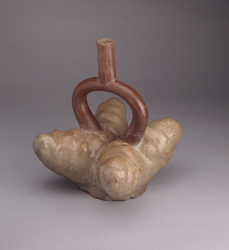History of the potato
History of the Potato
The potato (Solanum tuberosum) is a starchy, tuberous crop from the perennial nightshade family Solanaceae. It is native to the Americas, specifically the region of modern-day southern Peru and northwestern Bolivia. The potato has played a fundamental role in the agricultural, cultural, and culinary history of the world since its domestication over 7,000 years ago. This article explores the journey of the potato from its origins to becoming a global staple.
Origins and Domestication[edit | edit source]
The domestication of the potato is believed to have occurred between 8000 and 5000 BC in the region of Lake Titicaca, a high plateau straddling the border between Peru and Bolivia. Indigenous peoples of this region developed the cultivation techniques that allowed for the wide variety of potatoes seen today. Archaeological evidence, including remnants of potatoes found at archaeological sites, suggests that these early cultures had a sophisticated understanding of breeding and storing potatoes.
Spread to Europe[edit | edit source]
The potato was introduced to Europe by Spanish explorers in the early 16th century. Initially, it was met with suspicion and was believed to be unfit for human consumption by many Europeans. However, by the late 16th and early 17th centuries, the potato had begun to gain popularity, particularly in Spain, Italy, and Ireland, due to its ability to grow in diverse climates and its nutritional value.
Impact on Ireland[edit | edit source]
The potato became a staple food in Ireland due to its ability to produce a high yield in poor soil conditions. However, this dependence on a single crop led to disaster when a potato blight, caused by the fungus Phytophthora infestans, struck in the mid-19th century. The Great Famine of 1845-1852 resulted in the death of approximately one million people and the emigration of more than a million more, significantly impacting the demographic and cultural landscape of Ireland and the United States.
Global Spread[edit | edit source]
Following its acceptance in Europe, the potato was introduced to other parts of the world by European colonizers and traders. It became an important crop in Asia and Africa, where it was adapted to local cuisines and agricultural practices. Today, the potato is one of the world's major food crops, with China, India, Russia, Ukraine, and the United States being among the largest producers.
Cultural Significance[edit | edit source]
The potato has not only been a source of sustenance but has also played a significant role in cultural traditions and cuisines around the world. From the Irish colcannon to the Indian aloo gobi, and the Russian potato salad, the versatility of the potato has made it a staple ingredient in many dishes.
Scientific and Agricultural Developments[edit | edit source]
The 20th and 21st centuries have seen significant scientific advancements in the cultivation and breeding of potatoes. Genetic engineering and sustainable farming practices have been applied to improve disease resistance, nutritional value, and yield. These developments have helped to secure the potato's place as a vital food source for the growing global population.
Conclusion[edit | edit source]
From its humble origins in the Andean highlands to its status as a global staple, the potato has had a profound impact on the world. Its history is a testament to human ingenuity in agriculture and the ability of a single crop to influence the course of history.
Navigation: Wellness - Encyclopedia - Health topics - Disease Index - Drugs - World Directory - Gray's Anatomy - Keto diet - Recipes
Search WikiMD
Ad.Tired of being Overweight? Try W8MD's physician weight loss program.
Semaglutide (Ozempic / Wegovy and Tirzepatide (Mounjaro) available.
Advertise on WikiMD
WikiMD is not a substitute for professional medical advice. See full disclaimer.
Credits:Most images are courtesy of Wikimedia commons, and templates Wikipedia, licensed under CC BY SA or similar.
Contributors: Prab R. Tumpati, MD





